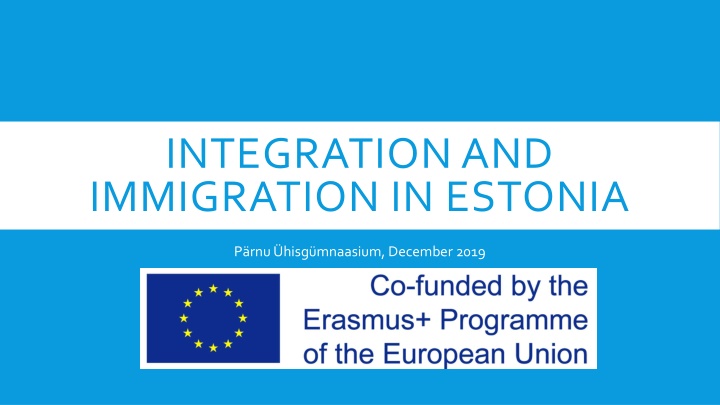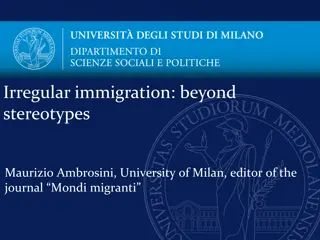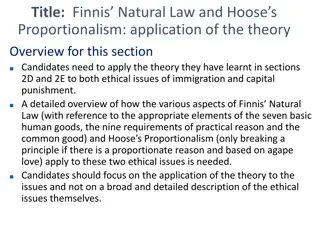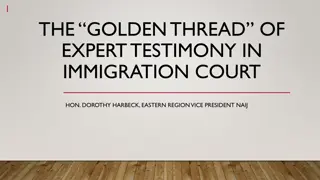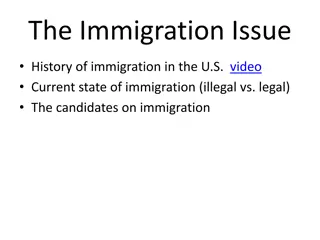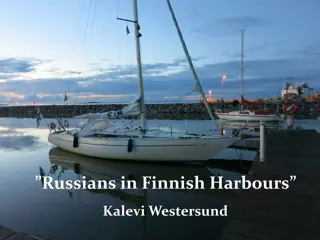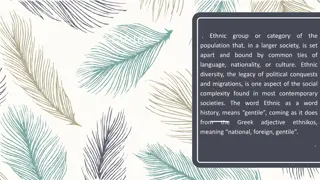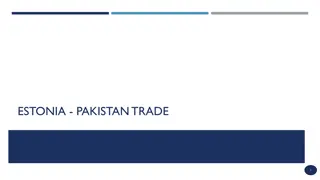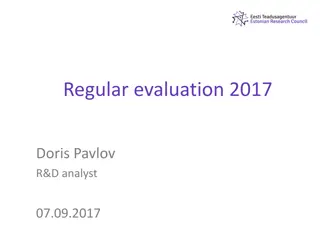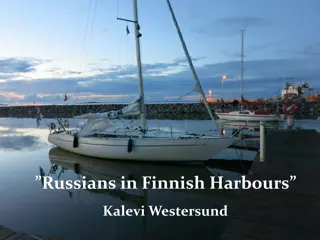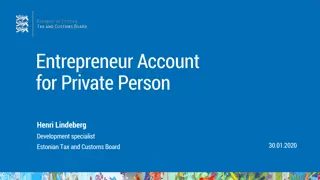Integration and Immigration in Estonia - Demographics and Ethnic Groups
Estonia, a diverse nation with a rich history of immigration, has faced challenges and changes in its ethnic composition over the years. From the Soviet occupation to the present day, the country has witnessed shifts in its demographic landscape, with notable percentages of Russians and other ethnic groups contributing to the cultural tapestry of Estonia.
Download Presentation

Please find below an Image/Link to download the presentation.
The content on the website is provided AS IS for your information and personal use only. It may not be sold, licensed, or shared on other websites without obtaining consent from the author.If you encounter any issues during the download, it is possible that the publisher has removed the file from their server.
You are allowed to download the files provided on this website for personal or commercial use, subject to the condition that they are used lawfully. All files are the property of their respective owners.
The content on the website is provided AS IS for your information and personal use only. It may not be sold, licensed, or shared on other websites without obtaining consent from the author.
E N D
Presentation Transcript
INTEGRATION AND IMMIGRATION IN ESTONIA P rnu hisg mnaasium, December 2019
DEMOGRAPHICS AND ETHNIC GROUPS OF ESTONIA Today, Estonia is ethnically diverse. In 2008, thirteen of Estonia'sfifteen counties were over 80% ethnic Estonian. Estonia had 15 counties in 2008. In 13 counties there were over 80% of ethnic Estonians. The counties with the highest percentage of Estonians are the islands of Hiiumaa (98,4%) and Saaremaa (98,3%). However in Harju County (which includes the capital Tallinn) and Ida-Viru County next to the Russian border in north-east of Estonia, ethnic Estonians make up only 59.6% (55.0% in Tallinn). In those two counties, Russians account for 32.4% (36.4% in Tallinn) and 71.2% of the population,respectively. In the nation as a whole, Russiansmake up24.8% of the totalpopulation.
Accordingto dataof 2008, the largestethnicgroupsin Estonia are Estonians(68.7%), Russians(25.6%), Ukrainians(2.1%), Belarusians(1.2%), and Finns(0.8%). Thesefivegroups made up98.4% of Estonia'spopulation. Representatives of 194nationalities live in Estonia. More than 300 cultural associations and 30 Sunday schools of different nationalities operate in Estonia (in 2018), keeping their native languages, customs and handicraft skills alive.
HISTORICAL BACKGROUND After the occupation of Estonia by the Soviet Union in 1940, repression of ethnic Estonians followed. Almost all societies, newspapers, organizations of ethnic Estonians were closed in 1940 and their activists persecuted. The country remained annexed to the Soviet Union until 1991, except for the period of Nazi occupation between 1941 and 1944. During the era of Soviet occupation, the Soviet government maintained a program of replacing the indigenous Estonians with immigrants from the Soviet Union. In the course of violent deportations, thousands of Estonian citizens were deported to the interior parts of Russia (mostly Siberia), and huge numbers of Russian-speaking Soviet citizens were encouraged to settle in Estonia. Entire families, including children and the elderly, were deported without trial or prior announcement. Of March 1949 deportees, over 70% of people were women and children under the age of 16. In the Ida-Viru and Harju Counties, cities such as Paldiski, Sillam e, and Narva were ethnically cleansed and the indigenousEstonianpopulationwastotallyreplacedby Russiancolonists. As aresultofSovietoccupation,theRussianpopulationinEstoniagrewfromabout 23,000 people in 1945 to 475,000 in 1991, and the total Slavic population to 551,000, constituting 35% ofthetotal populationatits peak.
INTEGRATIONAND ETHNICCOHESIONOF THE ESTONIAN SOCIETY Estonia has largely managed toavoidviolent, ethnicity-based manifestations, with the exception of the 2007 BronzeSoldier events. The Bronze Night (Pronksi ), also known as the AprilUnrest (Aprillirahutused) and April Events (Aprillis ndmused), is the controversy and riots in Estonia surrounding the 2007 relocation of the BronzeSoldier of Tallinn, theSovietWorld War II memorial in Tallinn. Many ethnic Estonians considered the BronzeSoldier in the city centre a symbol of Soviet occupation and repression. At the same time the monument has a significant symbolic value toEstonia'sRussian community, symbolising not only Soviet victoryoverNaziGermany inWorldWar II, butalsotheir claim toequal rights in Estonia.
The 2010 Integration Monitoring Report (2010 IMP) identified a number of positive trends. Thus, interactions between ethnicities and proficiency of ethnic minorities in the Estonian language during last five years have increased. The level of political activity among various ethnic groups has increased and the political values among ethnic groups have become increasingly shared. Radical positions in the public sphere among ethnic groups are becoming less frequent. Proficiency in Estonian language among ethnic minorities continues to grow. However, the number of ethnic minorities who are fluent in Estonian language is still rather modest. Interestinlanguage learning among ethnic minorities ishigh. Conversely, the statistical data and surveys repeatedly indicate significant socio-economic gap between ethnic groups and a very low trust in political institutions by ethnic minorities. The survey measuring self-evaluation of personal economic hardship found that only 6% of ethnic minorities live well with the current income and are able to save money (in comparison to 21% of Estonians). On average, income of ethnic minorities is considerably lower. In this context, the most disadvantageous group is that of female ethnic minorities earning only 55%of the average Estonianman.Theunemployment rate isveryhigh. The latest statistical data suggest that roughly 50% of ethnic minorities can understand, read, communicate andwrite inEstonian on mediumandadvanced levels.
The recent study on educational inequalities among the ethnic groups points to growing differences intheeducationallevelsofthe ethnicgroups.Someofthe reasons forgrowing inequalities are the institutional conditions and political choices adopted after 1991: instead of a gradual change in the education system the government chose to start a quick transition to teaching in only Estonian language in higher education and now also in mostofthe Estoniantowns onhighschoollevel. At the same time the quality of Estonianlanguage instruction in Russianbasic schools and secondary schools is OFTEN rather poor. It means that Russian speaking school leavers findthemselves atadisadvantageinaccesstothe nextlevelofeducation. Since every fourth inhabitant in Estonia is Russian, the state pays for education in Russian language, but to ensure integration schools have to teach a certain proportion of the curricula in Estonian - currently 60 percent in the state language and 40 percent in minoritylanguage). It iscalledthe60/40model.
GOOD SIGNS THOUGH There is a difference between the attitude of older and younger generation of ethnic Estonians to Russians and vice versa. The younger generations are more tolerant and eager to cooperate. Serving together in Estonian Defence Forces (Russian-speaking young men who have Estonian Citizenship want to serve in the Forces). Several Language Immersion Programs (keelek mblus) and more projects granted by the Integration Association of Estonia.
MIGRANTS/REFUGEES IN ESTONIA? Estonia has seen a steady influx of foreigners who come here to work and study, or who move here for family and other reasons. Compared to all of them, the amount of people who have been granted international protection is relatively small. For example, in 2015 a total of 8,104 foreigners were granted a temporary residence permit or registered their place of residence in Estonia whereas the number ofpeople who appliedforinternational protection was231. Over the years (1997- 2015), Estonia has received the largest number of applications for international protection from the Ukraine (155 applications), Russia(87),Georgia (79),Syria(51), Afghanistan (48) andIran(40). Not many migrants/refugees from Middle-EastandAfrica because: - the lack ofgood grants for the refugees inEstonia; - the lack oftheir community inEstonia; - Therefugee centers are far from the biggesttownsinisolatedareas. But in general, thanks to Estonia s outstanding e-solutions and friendly and helpful officials, coming to Estoniato live,work andstudycouldn t beeasier!
DEVELOPMENT PLAN? The preparation of a newnational integrationplanfor 2021-2030 isunderway at the Ministryof Culture, which willformulate the objectives of the integration policy of the Republicof Estonia and the activities neededto achieve them. Estonian Language Houses offer various language learning possibilities. They invite people to visit them and find the most suitable way of learning. - Language courses learning the language in a group under the guidance of a teacher. - Tandem studies language learning where you can study Estonian with Estonians who also wish to study your native language - Language caf s an opportunity to communicate in free form on various subjects and enrich your language skills.. - Digital learning independent studies in a web environment plus regular consultations with a teacher. Courses for A1, B1 and B 2 are the most popular. Registration takes place twice a year and people rush to register.
Other opportunities: - Estonian language and culture clubs language practice by visiting different cultural events. - Learning aid help with language review of simple texts. - Designed for young people aged 13-18, the camps are an opportunity for them to study Estonian, get to know local kids of their own age and learn more about the country s cultural environment. They go sightseeing and on excursions and play sport together. - On 7 October Integration Foundation and College of Tallinn University of Technology signed the agreement of cooperation. According to that Estonian language courses and consultations will take place in their rooms. The Estonian languagecourses, events andconsultationsare free of charge.
WHAT HAS TO BE DONE? Integration must start from the kindergarten. Special attention should be paid to integration at school (especially history classes - correct interpretation of history!). Russian-speaking students communicate with each other in Russian in school. They should be encouraged to communicate in Estonian!
SITUATION IN OUR SCHOOL We have Russian-speaking students in our school: this school year 19students out of 349. They are Russiansand Ukrainiansby their roots. We teach Estonian as a second languagefor Russian-speaking students. They have complementary lessons in Estonian in small groups. There is a Russian proverb that it is easier to live with a song P rnu hisg mnaasiumhas organised the festival of Russian Songs for 5 years. Our aims were based on the principles of the European year of Cultural Heritage giving high value to our communities of cultural and linguistic minorities. The main aim of the project is achievement of common understanding and tolerance, finding common human values irrespective of religious, ethnical or cultural-linguistic background. In February 2020, you will attend our Festival Songs of Various Nations !
THANK YOU FOR LISTENING! WELCOME TO THE FESTIVAL! SEE YOU IN ESTONIA IN P RNU HISG MNAASIUM IN FEBRUARY 2020!
